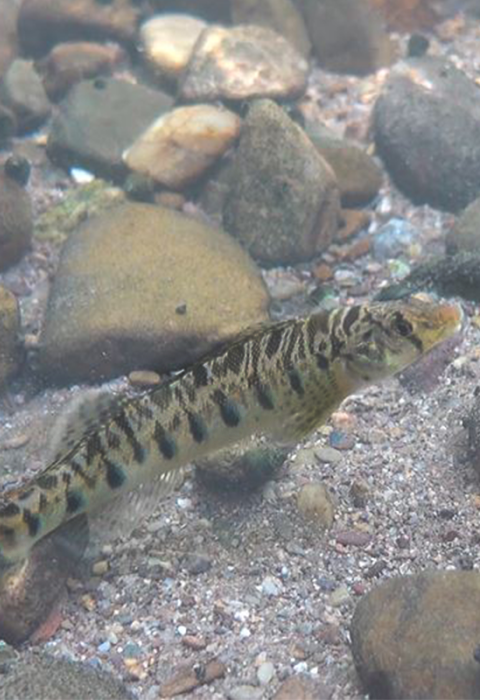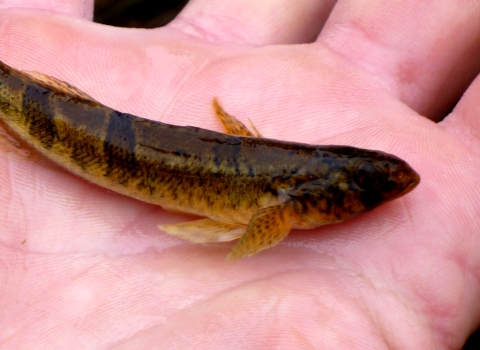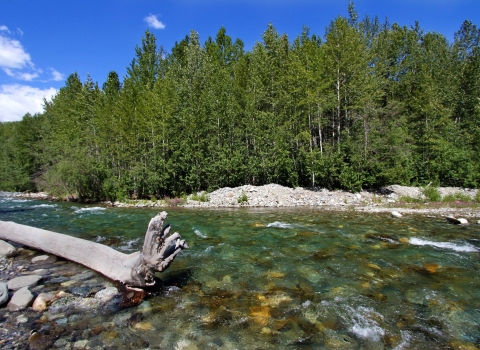Based on a review of the best available science, the U.S. Fish and Wildlife Service (Service) has determined that the Roanoke logperch, a large freshwater darter, is no longer at risk of extinction. The Service is proposing to remove the fish from the endangered species list.
The Roanoke logperch, or Percina rex, is known as the king of the darters because of its size relative to others in the family. These fish grow to six inches long, on average, have strongly patterned fins and can be identified by the orange band on their dorsal fins. This band is particularly bright on mature males. Roanoke logperch have noticeably bulbous snouts, which they use to overturn small pebbles and shells when hunting for invertebrates.
These resourceful fish will use all parts of the stream over the course of their lifetimes. They need fast-moving water for foraging. The quick current washes fine sediment from gravel, leaving small pebbles and shells for logperch to overturn when hunting for food. They will also spawn in these strong currents. The fertilized eggs then float downstream to be distributed among the slower-moving shallow pools at the water’s edge.
When the Roanoke logperch was listed as endangered in 1989, it was found in only 14 streams. In the years since, Roanoke logperch surveys and habitat restoration have more than doubled the species range, with 31 occupied streams as of 2019. It can be found in larger streams in the upper Roanoke, Smith, Pigg, Otter, and Nottoway River systems and Goose Creek in Virginia and in the Dan, Mayo, and Smith River systems and Big Beaver Island Creek in North Carolina.
This delisting is largely a result of successful Roanoke logperch surveys and aquatic-restoration projects led by the Service and its partners. With help from the Service’s National Fish Passage Program, Natural Resource Damage Assessment and Restoration settlement funds, Partners for Fish and Wildlife Program funds, and/or funding provided by other partners, multiple dams and barriers have been removed in both Virginia and North Carolina, connecting hundreds of miles of Roanoke logperch habitat. Nationwide, the program has helped remove over 3,400 barriers to aquatic connectivity and reopened access to over 61,000 stream miles.
In 2021, the Bipartisan Infrastructure Law Bipartisan Infrastructure Law
The Bipartisan Infrastructure Law (BIL) is a once-in-a-generation investment in the nation’s infrastructure and economic competitiveness. We were directly appropriated $455 million over five years in BIL funds for programs related to the President’s America the Beautiful initiative.
Learn more about Bipartisan Infrastructure Law (BIL) invested an additional $200 million for fish passage fish passage
Fish passage is the ability of fish or other aquatic species to move freely throughout their life to find food, reproduce, and complete their natural migration cycles. Millions of barriers to fish passage across the country are fragmenting habitat and leading to species declines. The U.S. Fish and Wildlife Service's National Fish Passage Program is working to reconnect watersheds to benefit both wildlife and people.
Learn more about fish passage projects over the next five years. In the past two years, the Service and its partners have started 35 Infrastructure Law-funded fish-passage projects that support the recovery of more than 40 endangered and threatened species.
In coordination with its partners, the Service is developing a plan to monitor the Roanoke logperch for no less than five years after delisting, to detect any change in status that would indicate it needs additional conservation or should be relisted.
The Service encourages any interested parties to provide input and substantive comments during the 60-day comment period. The proposal to remove the Roanoke logperch from the Endangered Species Act will publish in the Federal Register April 2, 2024.



